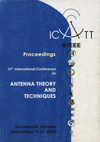Analytical method for solving inverse problem in magnetocardiology
DOI:
https://doi.org/10.1109/ICATT.2003.1238882Keywords:
magnetocardiology, magnetic dipole, inverse problemAbstract
Analytical method for solving inverse problem in magnetocardiology is presented. The suggested approach uses Fourier transform and eigen values and vectors method to define spatial location and magnetic moment components of a single magnetic dipole, which is considered to be source of weak magnetic field produced by human heart. The results of numerical solution of the inverse problem are presented. The analytical method and software developed are important for medical investigations of human heart and brain.References
Schwarz, B.; Foner, S. Weak superconductivity. Quantum interferometers, their application. M.: Mir, 1980 (in Russian).
Wynn, W.M. Advanced superconducting gradiometer/magnetometer arrays and a novel signal processing technique. IEEE Trans. Magn., 1975, Vol. 11, p. 701-707.
Skiles, D. Geomagnetic field, it's nature, history and meaning for biology. Biogenic magnetite and magnetoreception. New in biomagnetism, Vol. 1. Mir, 1989, p. 63-144 (in Russian).
Yarotsky, V. Methods of detection and determination of location of objects by their permanent magnetic field. Foreign rodioelectronics, 1984, No. 3, p. 45-56.
McAulay. Computerized model demonstrating magnetic submarine localization. IEEE Trans. Aerospace Electron Systems, 1977, Vol. 13, p. 246-254.
Tikhonov, V.; Shalaev, B. Inverse tasks solution features in electromagnetic investigations of the sebaceous mediums. News of Leningrad electrotechnical institute named after V. I. Ulyanov (Lenin), 1983, 327, p. 24-29.
Ionnidis, G. Identification of ship or submarine from its magnetic signature. IEEE Trans. Aerospace Electron. Systems, 1977, Vol. 13, p. 327-329.
Burstein, D.; Cohen, D. Comparison of magnetic field and electric potencials produced by frog heart muscle. IEEE Trans. Aerospace Electron. Systems, 1985, Vol. 57, No. 7, p. 2640-2646.
Grynszpan, F.; Geselowitz, D. Model studies of magnetocardiogram. Biophys. J., 1973, Vol. 13, p. 911.
Karp, P. Cardiomagnetism. Biomagnetism, 1981, p. 219-230.
Hamalainen, Matti; Hari, Riitta; et al. Magnetoencephalography - theory, instrumentation, and applications to noninvasive studies of the working human brain’. Rev. Mod. Phys., 1993, Vol. 65, No. 2.
Gumeniuk-Sychevskiy, V.I.; Primin, M.A.; Nedayvoda, I.V. Algorithm of the Numerical Realization for Solving the Inverse Problem in Magnetostatics for Biomagnetic Source Localization. UsiM, 1993, No. 1, p. 97-107.
Tamm, I.E. Fundamentals of the Thoery of Electricity. Nauka, 1989, 504 p. (in Russian).
Shimoni, K. Theoretical Electrotechnics. Mir, 1964, 773 p. (in Russian).
Kohrn, G.; Kohrn, T. Mathematical Handbook for Scientists and Engineers. Nauka, 1984, 831 p. (in Russian).
Vanstein, L. Electromagnetic waves. Sovetskoe Radio, 1957, 453 p. (in Russian).

